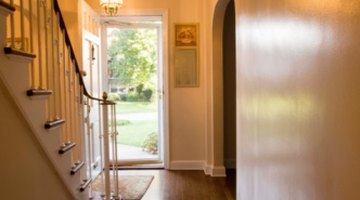How to Remove Hardwood Flooring Bubbles
Hardwood floors add value to a home. Most hardwood floors have a protective clear coating added after installation to protect the wood from moisture and scratches caused by everyday use. This protective coating is polyurethane applied in liquid form to the wood.

If a polyurethane finish is improperly applied, bubbles will appear in the clear coat and will be extant after the polyurethane dries. Repairing bubbles within the finish of a hardwood floor requires removal of the old finish with floor screening pads and applying a new polyurethane finish.
Things You Will Need
- Medium-abrasive screening pad
- Floor buffer
- Wet/dry shop vacuum
- Fine-abrasive screening pad
- Polyurethane finish
- Paintbrush
- 100-grit sandpaper
- Face filter mask
Tip
Depending on individual taste, you may want to add extra coats of polyurethane. Make sure you sand and vacuum between each coat except the very last.
Warning
Always open windows and use a face filter mask when using polyurethane.
-
Remove everything within the room where you will be working on the floors. The dust from the floor buffer can land and attach onto surfaces such as fabric furniture.
-
Attach a medium-abrasive screening pad to a floor buffer. Floor buffers and screening pads are available at most hardware and home improvement stores for hourly or daily rental.
-
Turn the floor buffer on and begin moving it on the hardwood floor, starting at the farthest corner of the room and working in the direction of the wood boards. The floor-screening pad will grind off the top coat of the polyurethane finish, removing all the unsightly bubbles.
-
Sand the hardwood floor until you have completed the entire area. Avoid allowing the floor buffer to stand in place while it's running, as this may allow the screening pad to grind down to the actual wood of the floor, causing damage or floor dips.
-
Vacuum all the sanding dust off the hardwood floor with a wet/dry shop vacuum.
-
Attach a fine-abrasive pad to the floor buffer. Turn the floor buffer on and sand the entire floor again, working from the farthest corner out and working in the direction of the hardwood boards.
-
Vacuum the entire hardwood floor again with the shop vacuum to remove all traces of sanding dust.
-
Don your face mask. Open windows if possible. Open the can of polyurethane finish and stir it with a wooden stick. Apply the polyurethane finish onto the hardwood floor with a paintbrush in even strokes. Spread the polyurethane finish over the floor beginning in the farthest corner and brushing in the direction of the wood boards until the entire floor is coated. Allow the polyurethane finish to dry overnight.
-
Buff the entire floor with extra-fine sandpaper (100-grit). By sanding the first coat of polyurethane, the second coat will adhere better to the hardwood floor. This sanding process will also ensure you have no bubbles in the finish.
-
Vacuum all sanding dust from the hardwood floor with the wet/dry shop vacuum.
-
Apply the second coat of polyurethane with a paintbrush over the entire wood surface in the same way as the first coat. Allow the second coat of polyurethane finish to dry to up to 48 hours before walking on the floor or moving furniture back onto the floor. Be sure to wear your mask again.
The Drip Cap
- Hardwood floors add value to a home.
- Attach a medium-abrasive screening pad to a floor buffer.
- The floor-screening pad will grind off the top coat of the polyurethane finish, removing all the unsightly bubbles.
- Vacuum the entire hardwood floor again with the shop vacuum to remove all traces of sanding dust.
- Spread the polyurethane finish over the floor beginning in the farthest corner and brushing in the direction of the wood boards until the entire floor is coated.
References
Writer Bio
Rachel Turner has been writing professionally since 2000, focusing on gardening and home improvement topics. Her articles have appeared online at SlowTravel and in publications such as the "Arkansas Gardeners," "One Step Ahead" and "Writers Now." Turner holds a Bachelor of Arts in English from Arkansas State University.
Photo Credits
- Jupiterimages/Creatas/Getty Images
- Jupiterimages/Creatas/Getty Images
More Articles



